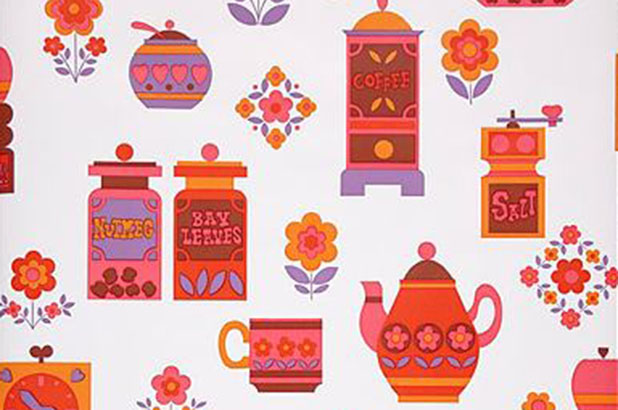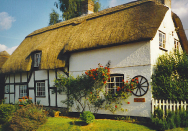If books are the first thing you think of when you hear the word ‘library’ think again! Our library, at The Mint in Macquarie Street Sydney, is also home to a rich collection of material relating to the history of house and garden design and interior furnishings. Far from just having books, The Caroline Simpson Library & Research Collection includes architectural fragments and garden ornaments, soft furnishings and trimmings, wall and floor coverings, manufacturers’ trade catalogues and sample books. Curator Michael Lech is guest blogger this week, peeling back the layers of time to reveal past tastes in kitchen decor.
Wallpapers for the kitchen
From the early 20th century, the kitchen gradually assumed a more important role within the home. Instead of being ostracised to the back of the house, the kitchen was located more centrally within most homes and consequently, the fittings and look or decoration of the kitchen were also upgraded. Kitchen surfaces (including walls) are more prone to bumping and dampness and wear and tear than most other parts of the house. Consequently wallpapers for the kitchen needed to be sturdy. Wallpapers that were relatively easy to clean, known as ‘sanitary wallpapers’, were first invented in the early 1870s. The surface was however, still prone to dampness and although other wallpaper surfaces were subsequently invented, it was the adoption of vinyl coated wallcoverings after World War II (and especially from the 1960s in Australia) that allowed kitchens to be covered with wallpapers that were simple to maintain.
- The Australian Home Beautiful, November 1925. Caroline Simpson Library & Research Collection, Sydney Living Museums
- ‘Mosaik’ wallpaper, design by Edith Brondal for Danske Tapetfabrikker, Denmark, c1958. Caroline Simpson Library & Research Collection, Sydney Living Museums, gift of Barbara Stuart L2007/47
- Fruit a plenty’ wallpaper, The Birge Company Inc, United States of America, c1961. Caroline Simpson Library & Research Collection, Sydney Living Museums, gift of Chee Soon & Fitzgerald L2008/157
- ‘Tea Time’ in a pink colourway, The Birge Company Inc, United States of America, c1961. Caroline Simpson Library & Research Collection, Sydney Living Museums, gift of Chee Soon & Fitzgerald L2008/171
- ‘Tea Time’ in a yellow colourway, The Birge Company Inc, United States of America, c1961. Caroline Simpson Library & Research Collection, Sydney Living Museums, gift of Chee Soon & Fitzgerald L2008/194-1
- ‘Hyde Park’ design, Sunworthy brand wallpaper, Canadian Wallpaper Manufacturers Ltd., Canada, c1965. Caroline Simpson Library & Research Collection, Sydney Living Museums L91/5-7
- Cobalt blue tile wallpaper, Florence Broadhurst Wallpapers Pty Ltd, Sydney, c1968. Caroline Simpson Library & Research Collection, Sydney Living Museums L2001/3-5
- Pots and canisters wallpaper, c1970. Caroline Simpson Library & Research Collection, Sydney Living Museums, gift of Chee Soon & Fitzgerald L2008/241
- Design for an ice making machine, which worked on a chemical reaction to produce the freezing temperatures required. E.D. Nicolle – miscellaneous papers, including E.D. Nicolle’s passport and articles relating to refrigeration engineering, ca. 1851-1910. State Library of NSW A 2751
Early wallpaper designs specifically for the kitchen were limited, the most common being a basic tile pattern, in imitation of but less expensive than ceramic tiles. The tile pattern has subsequently been adapted to multiple forms and colours almost to the present day. For example, when interior designer Kevin Hambly was planning the refit of his Sydney kitchen in the late 1960s, he selected a wallpaper with a tile design from Florence Broadhurst’s studio in the Sydney suburb of Paddington. Because Broadhurst’s wallpapers could be printed in small batches in almost any colour desired, Hambly chose a vivid cobalt blue to go with yellow canvas window blinds, Tasmanian oak cupboards and white kitchen benchtops.
The use of kitchen-related motifs on kitchen wallpaper designs that might include depictions of food, cooking utensils, dinnerware and/or cutlery also became popular from the 1950s. But possibly the most important feature of wallpapers for the kitchen from World War II to about the 1980s was that they should brighten the kitchen and give a cheery appearance. Consequently, vivid colours on a white or cream ground were favourite wallpaper choices for Australian kitchens. Installing wallpapers has always been an easy way to quickly transform the decoration of a room, and when kitchens have needed transforming, wallpapers were often the solution.
Michael Lech
Curator, Caroline Simpson Library & Research Collection












